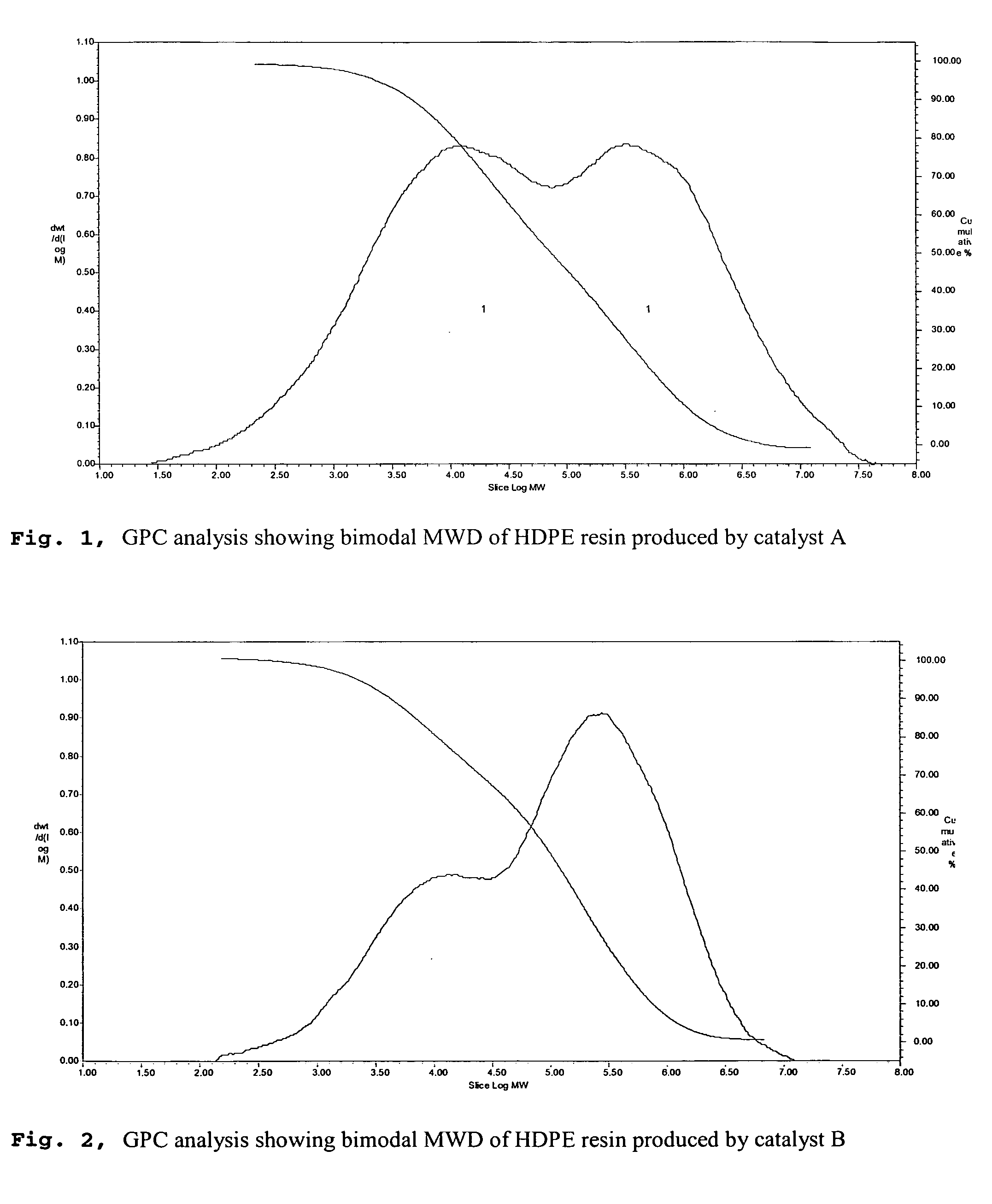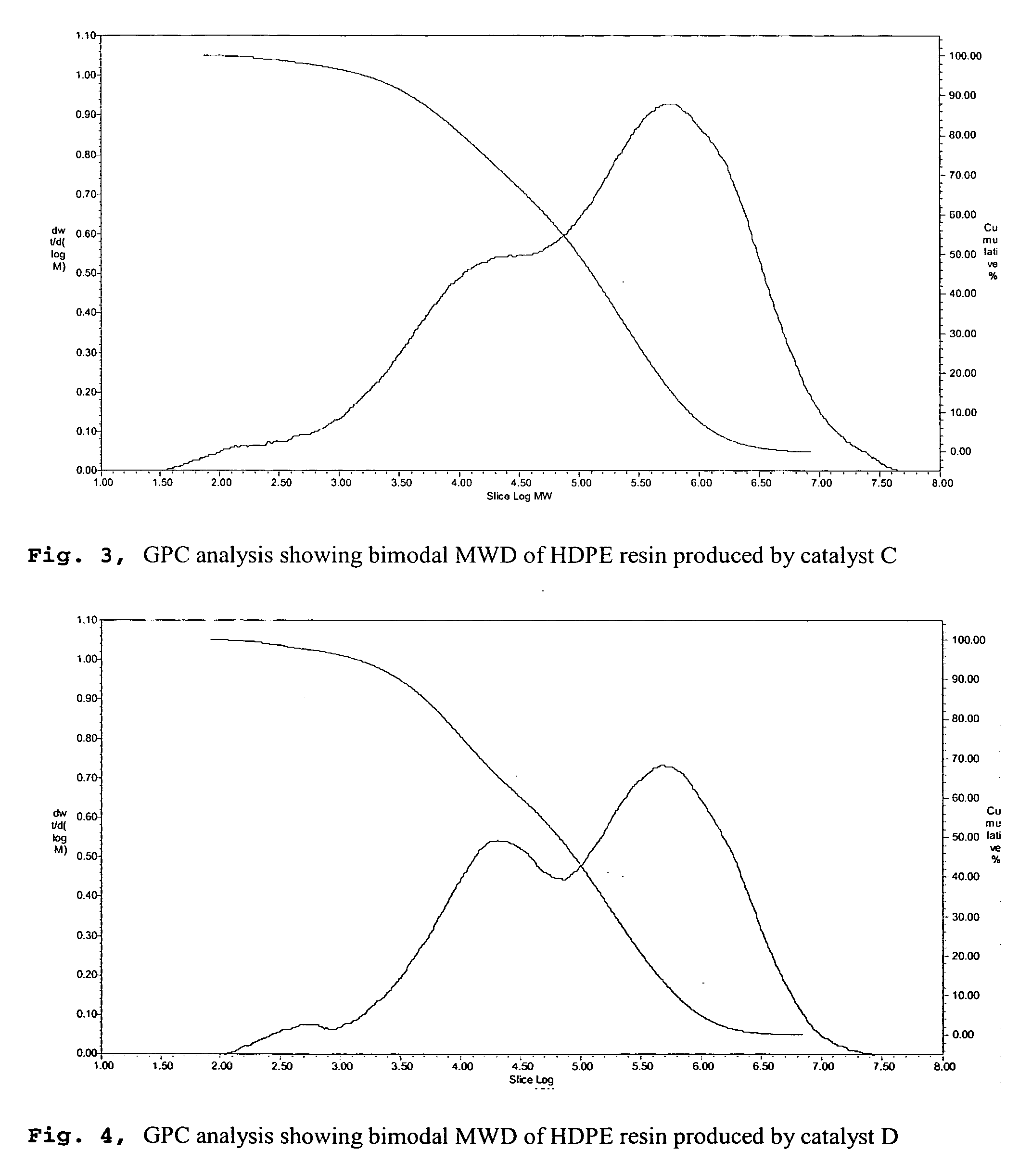Polymer supported metallocene catalyst composition for polymerizing olefins
- Summary
- Abstract
- Description
- Claims
- Application Information
AI Technical Summary
Benefits of technology
Problems solved by technology
Method used
Image
Examples
example 1
Synthesis of Catalyst (A)
[0035]To a three-necked round bottom flask, equipped with a condenser and magnetic stirrer, 10 g of polyvinylchloride spheres of 30 μm average particle size was added. The flask containing the polyvinylchloride spheres was heated to 70° C. using an oil bath and then evacuated at 30 mm Hg pressure for 30 minutes. The flask and its contents were then purged with dried nitrogen and the polyvinylchloride spheres were then slurried using 30 cm3 of iso-pentane. Then 3 cm3 of butylmagnesium chloride (2M) was added to the slurry at 45° C. and the resultant mixture was stirred for 30 minutes at room temperature. Then 0.025 cm3 of 100 wt % pure ethanol was syringed into the flash via rubber suba-seal and the contents stirred for about 5 minutes at room temperature. The temperature of the oil bath containing the flask was raised to 55° C., and it was subjected to nitrogen purging under continuous stirring for about 15 minutes to evaporate the iso-pentane solvent from t...
example 2
Ethylene Homopolymerization
[0036]An autoclave with a volume of 2 liters was purged with nitrogen at 130° C. for 30 minutes. After cooling the autoclave to 80° C., one liter of n-hexane was introduced into the reactor. The reactor was then pressurized to 0.4 bar with hydrogen and then to 15 bar with ethylene. Thereafter, 4 cm3 of M-MAO type 3A (7% wt Al) from Akzo-Nobel was injected into the reactor by the means of a catalyst injection pump. Next 0.08 g of the solid Catalyst A, described in Example 1, was injected into the reactor after being slurried in 20 cm3 of n-hexane. The reactor temperature was raised to 95° C. Ethylene polymerization was carried out for 60 minutes, with ethylene supplied on demand to maintain the total reactor pressure at 15 bar. In the reaction, 335 liters of ethylene were consumed and 432.5 grams of polyethylene was recovered giving a catalyst productivity of 5,406 g PE / g cat hr at 200 psig. The polymer had a bulk density of 0.301 g / cm3 and a fines level me...
example 3
Synthesis of Catalyst (B)
[0038]To a three-necked round bottom flask, equipped with a condenser and magnetic stirrer, 10 g of polyvinylchloride spheres of 30 μm average particle size was added The flask containing the polyvinylchloride spheres was heated to 70° C. using an oil bath and then evacuated at 30 mm Hg pressure for 30 minutes. The flask and its contents were then purged with dried nitrogen and the polyvinylchloride sphere were then slurried using 30 cm3 of iso-pentane. Then 3 cm3 of butylmagnesium chloride (2M) was added to the slurry at 45° C. and the resultant mixture was stirred for 30 minutes at room temperature. Then 0.025 cm3 of 100 wt % pure ethanol was syringed into the flash via rubber suba-seal and the contents stirred for about 5 minutes at room temperature. The temperature of the oil bath containing the flask was then raised to 55° C., and it was subjected to nitrogen purging under continuous stirring for about 15 minutes to evaporate the iso-pentane from the mi...
PUM
| Property | Measurement | Unit |
|---|---|---|
| Length | aaaaa | aaaaa |
| Length | aaaaa | aaaaa |
| Time | aaaaa | aaaaa |
Abstract
Description
Claims
Application Information
 Login to View More
Login to View More - R&D
- Intellectual Property
- Life Sciences
- Materials
- Tech Scout
- Unparalleled Data Quality
- Higher Quality Content
- 60% Fewer Hallucinations
Browse by: Latest US Patents, China's latest patents, Technical Efficacy Thesaurus, Application Domain, Technology Topic, Popular Technical Reports.
© 2025 PatSnap. All rights reserved.Legal|Privacy policy|Modern Slavery Act Transparency Statement|Sitemap|About US| Contact US: help@patsnap.com



